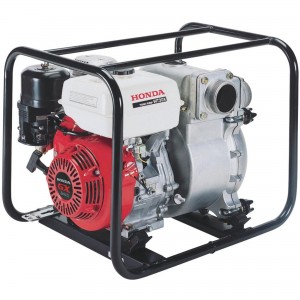Most people are familiar with working on small engines after owning lawn care equipment, but there are some unique challenges when maintaining water pumps. Here are some tips to keep your Honda water pump working reliably for years to come.
Oil
For the most part, checking and changing the oil in a water pump engine is no different from any other Honda-powered product. However, there’s always the chance that a leaking hose can spray the engine with water, letting it seep into the crankcase. This can create a sticky, light-colored emulsion that won’t lubricate the engine. If this happens, the oil should be changed immediately.
To check the oil, set the pump on level ground, remove the dipstick from the filler neck and wipe it clean. Insert it into the neck without screwing it in to get an accurate reading. When adding oil, it should come up to the top of the filler neck.
Most recent GX-Series engines used in Honda’s pumps come with the Oil Alert system. If the float inside the crankcase is too low, it will cut power to the ignition to prevent engine damage. If you have starting problems, start by checking the oil level.
Pump Case and Strainer
All models except electric and mini 4 stroke-powered pumps have a separate pump case. This case should be flushed after each use. Trash pumps have a clean out port, while all other pumps can be cleaned by spraying the outlet and inlet of the pump with a garden hose until the runoff is clean.
If you hear grinding noises, debris may be entering the pump housing or a clogged strainer is preventing steady water flow, resulting in cavitation. Either way, the pump should be shut off immediately and the strainer should be checked for damage and debris build-up.
Fuel
Honda recommends using Unleaded fuel that is at least 87 Octane and no more than 10% ethanol or 5% methanol. Fuel should be treated with a stabilizer if it won’t be used for at least a month after purchase and should be replaced entirely after three months, even if it has been treated. Since most pump use isn’t on a set schedule, it’s a good idea to treat all fuel used in your equipment. Stale fuel can be safely used in cars where it will be diluted by fresh fuel and be easier to burn thanks to the engine’s fuel injection system.
The fuel level should only come up to the bottom of the filler neck, and the holes in the cap need to be clean. This lets the fuel expand and contract as temperatures change and allows air to enter the tank as gas is drawn into the fuel system.
Gear Box
Some models have a gear case between the engine and pump housing that contains a reduction gear. The oil inside should be replaced at least once a year with a GL5-rated 80W90 gear oil. Removing the old oil will be faster if you can run the engine for a few minutes to warm it up. When you do this, make sure the pump is off to prevent overheating that can ruin the seals. The dipstick should not be screwed in when checking the oil level, and the level needs to be rechecked once the case has been filled.
Pump Connecting Rod
The WDP30 uses a spring-loaded connecting rod to absorb shocks from rocks entering the pump. Honda recommends applying NLGI Category 2 grease, which is the standard grease for most mechanical and automotive applications. The rod shouldn’t be making direct contact with water, so this grease doesn’t need to be waterproof or designed for marine use.
Electric Pumps
These pumps should mostly be maintenance free. However, dirt can cause problems with the float switch and overall pump performance.
If the float is dirty and isn’t responding to water level changes, it just needs a thorough cleaning. If debris build-up on the inlet is causing problems, the volute case should be cleaned. To access the case, remove the screws that attach the lower part of the housing and pry the base and housing apart with a flathead screwdriver. Remove any debris in the case and pump base holes and make sure the impeller can spin freely. Never open up the pump itself: if it isn’t precisely reassembled and resealed, water can leak into the case, causing a short. Once everything is clean, reassemble the case.
Getting Parts for Your Pump
Hondalawnparts.com is a certified Honda Engines and Honda Power Equipment dealer, which means we’re able to offer all the parts and accessories you need for your pump including everything from spark plugs to hoses. Our site makes it easy to find what you need thanks to built-in factory parts diagrams and descriptions, and we can ship your order to any location in the U.S. or Canada.

